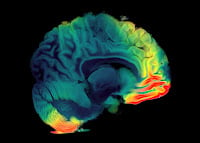Significant Brain Changes Found in Adults With Phobias, but Not Youth

Adults—but not youth—with phobia show significant and phobia-specific differences in brain structure compared with adults without any psychiatric illness, according to a report published in AJP in Advance. The brain imaging data also revealed that the neurological changes in adults with phobias were more profound than those observed in people with general anxiety or social anxiety.
Kevin Hilbert, Ph.D., of the Humboldt University of Berlin and colleagues with the ENIGMA (Enhancing Neuroimaging Genetics Through Meta-Analysis) consortium noted that a phobia is the most common anxiety disorder, with a prevalence of up to 12.5%. Yet “few studies have examined differences in brain structure associated with specific phobia, and those were generally conducted in small samples and targeted isolated regions of interest,” they wrote.
To address this gap, the ENIGMA team examined MRI scans from 1,452 children and adults with a specific phobia as well as 2,991 healthy participants. The most common phobia subtypes in the sample were animal phobias (739 participants) and blood/injury/injection phobias (182 participants).
The researchers found that individuals with phobia displayed increased thickness in some parts of the frontal cortex, as well as reduced subcortical volumes in the caudate nucleus, putamen, and hippocampus. The altered regions are involved in fear-related processes like movement, aversion, and emotional processing; notably, the size of the amygdala—a central regulator of fear and aggression—was not significantly altered in people with phobia.
Most of the differences in structure relative to healthy controls were seen in people with animal phobias. However, individuals with blood/injury/injection phobias showed increased thickness in the medial orbitofrontal cortex relative to both controls and people with animal phobias, which supports the idea that impairments in people with blood/injury/injection phobias involve higher cognitive processes such as evaluating external stimuli (which is why this phobia type can elicit both fear and disgust).
Interestingly, Hilbert and colleagues found no differences in brain structure between people with phobias and healthy controls when they compared only people under the age of 21—these differences seem to manifest during adulthood. [I]t was a surprising finding given that [phobia] onset early in childhood is so common and given that neurofunctional and structural correlates are observed in individuals with other anxiety disorders, and even in youths at risk for anxiety disorders,” they wrote.
Since many childhood phobias remit in adulthood, the large structural changes seen in the MRI scans of adults may reflect a more persistent form of the disorder, they added.
For related information, see the AJP article “Subcortical Brain Volume, Regional Cortical Thickness, and Cortical Surface Area Across Disorders: Findings From the ENIGMA ADHD, ASD, and OCD Working Groups.”
(Image: Getty Images/iStock/Ignatiev)
Don't miss out! To learn about newly posted articles in Psychiatric News, please sign up here.





